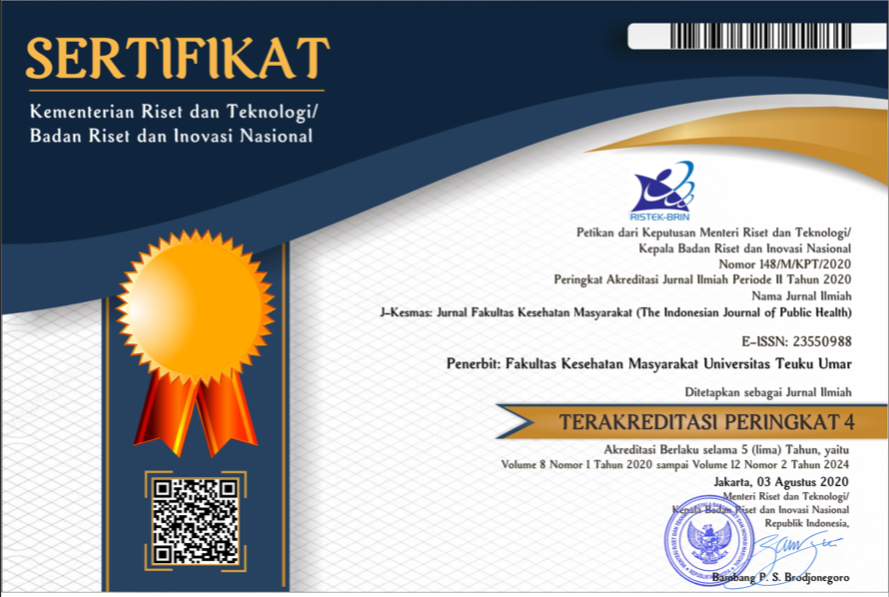Strategy to Reduce Low Birthweight Babies in West Aceh Regency
Abstract
Low birthweight babies are babies with a birth weight of 1,500 grams to less than 2,500 grams. Low birthweight babies are the cause of increase in babies’ mortality (death) and morbidity (pain). One of the primary risk factors of low birthweight babies is poor pregnant mother’s nutrition. Iron can provide a reserve or storage of nutrition that is very much needed by pregnant mothers to prevent anemia and maintain optimal growth of fetuses. The occurrence of low birthweight babies in Aceh Barat Regency is still very high. The design of this research was observational with an intervention of providing iron for 90 days to pregnant mothers and nutritional guidance for pregnant mothers in the effort of reducing the prevalence of low birthweight babies. The research was done in 10 villages from 3 rural sub-districts that contribute to high rates of low birthweight babies in Aceh Barat Regency, with 146 pregnant mothers. The results of the research showed that the application of the informal guidance strategy in a non-formal setting accompanied with discussions among family members and guidance targets resulted in 69.2% of guidance targets becoming motivated to consume Fe tablets and maintain eating patterns, while guidance targets that have been motivated yet did not consume Fe tablets and maintain eating patterns gave low income of guidance and Fe tablets were observed for 3 months; the result was 13 mothers (86.7%) gave birth to babies of normal weight and 2 mothers (13,3%) gave birth to underweight babies. The application of the guidance strategy in the effort to reduce the occurrence of low birthweight babies, from the results of this research, requires commitment from the Department of Health to provide suitable funds, facilities, and infrastructure to provide services to pregnant mothers, and commitment of all health officials in particular village nurses and health cadres, as well as involving the husband in the role to maintain a healthy pregnancy.
Full Text:
PDFReferences
Survey Demography Kesehatan Indonesia, 2012
Guyard, B. F. J. C. M. (1992). Determinants of prematurityand low birth weigh: Health Nutrition
UNICEF. (1999). Composition of a multi micronutrient supplement to be used in pilot programes among pregnant women in developing countries. New York: Word Health Organization.
Yulifah, R., & Yuswanto, T. J. A. (2009). Asuhan Kebidanan Komunitas. Jakarta: Salemba Medika
Illsley, R. R. G. M. (1984). Low birth weight a medical pychological and social study: Chi Chester: John Wileyand sons.
Winkjosastro, H. (2007). Ilmu Kebidanan. Jakarta: Bina Pustaka.
Depkes, R. (2001). Pedoman Pemantauan Kesehatan Ibu dan Anak.
Saifuddin, A. B. (2002). Buku Acuan Nasional Pelayanan Kesehatan Maternal dan Neonatal. Jakarta: Yayasan Bina Pustaka Sarwono Prairohardjo.
Najoan. N.W, S. W. (2002). Hubungan Serum Feritin Ibu Hamil Trisemester Ke Tiga dengan Bayi Berat Lahir Rendah. Manado: FK Universitas Samratulangi
Mubarak, W. I. (2009). Sosiologi untuk Keperawatan: Pengantar dan Teori. Jakarta: Salemba Medika
Profil Dinas Kesehatan Kabupaten Aceh Barat (2014). Meulaboh: Dinas Kesehatan Aceh Barat
Desphande, J. D., Phalde D.B, Bangal, V.B. (2011). Maternal Risk Factors for Low birth weight neonates: a hospitas Based Case Control Studiy in Rural Area of Western Maharastra India
National Journal Of Comunity Medicine, 2(3), 394-398.
DOI: https://doi.org/10.35308/j-kesmas.v6i1.1153
Refbacks
- There are currently no refbacks.
Managed by Fakultas Kesehatan Masyarakat
Published by Universitas Teuku Umar
Website: http://jurnal.utu.ac.id/jkesmas
Email: jkemas@utu.ac.id 
This work is licensed under a Creative Commons Attribution-ShareAlike 4.0 International License.







.jpg)


